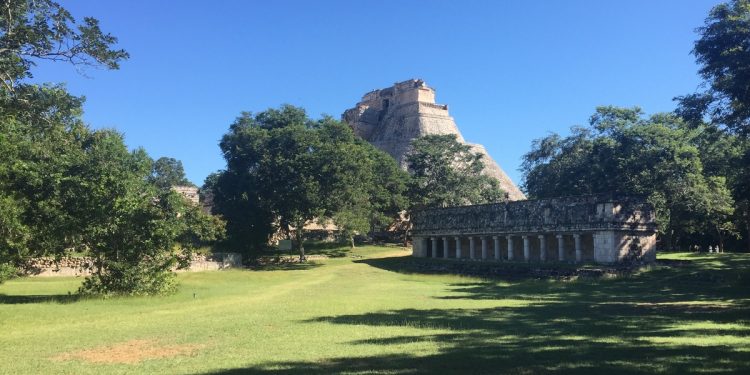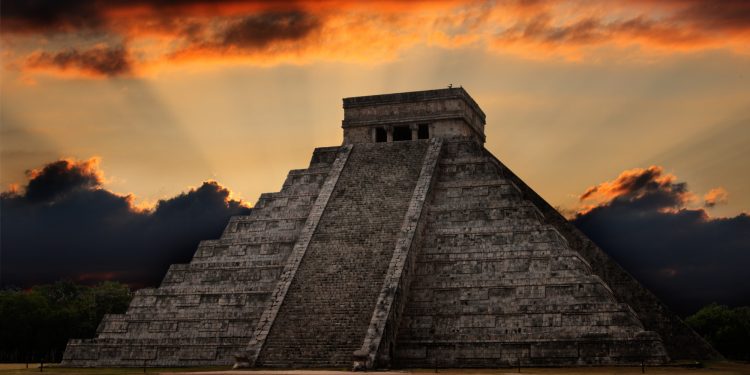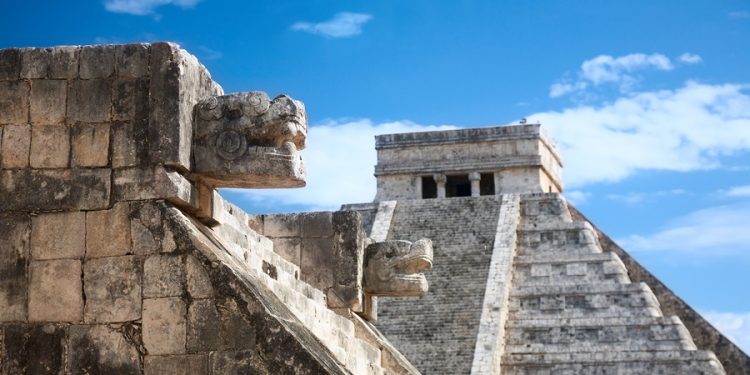Discover Uxmal
Uxmal (pronounced “oosh-MAHL”) is said to be among the most attractive of Mexico’s archaeology centers and should be included in any itinerary that intends to visit the most important Maya ruins.
Uxmal was an important city, probably built around 700 AD, although inhabitants are thought to have lived in the area as far back as 800 BC—nearly 1,000 years before the city was built.
It is a mystery as to why a settlement was ever made here: there are no rivers or local sources of water, and no evidence that they once existed. One of the important features of Uxmal are the chultunes (cisterns), which held water for the population to live from, and Chaac, the rain god, features prominently in much of the architecture’s carvings—no doubt an important source of water for the people that lived here.
Within a 10 mile radius of Uxmal are four other smaller ancient ‘towns’ of Kabah, Sayil, Xlapak, and Labna. Together with Uxmal, these places make up the Ruta Puuc, named after the hills in which these ruins are nestled and the architectural style of the buildings found at this and other Puuc sites.
Uxmal is a delightful archaeological site to explore and experience. During the rain season (May to October) the rich green fertile land provides a perfect setting for some of the most magnificent ancient pyramids, buildings, and temples of the ancient world. You can sense the history here as you walk around and gaze at the stunning architecture and majestic layout of this ancient city.
Key Attractions
The 120-foot high Piramide del Adivino (Magician’s Pyramid) stands majestically above the other buildings, and a climb to its summit will reward you with spectacular views of the entire half-square-mile ancient city.
The Cuadrángulo de las Monjas (Nuns’ Quadrangle) was believed to have been used for military purposes, perhaps an academy or palatial complex.
At the Palacio del Gobernador (Governor’s Palace) you can admire the 300 foot-long facade described by one scholar as the finest structure in Uxmal.
Other attractions include the Juego de Pelota (Games Court) which is nowhere near as large or impressive as the one in Chichen Itza; Casa de las Tortugas (House of the Turtles), one of the smallest buildings, but quaint and interesting all the same and La Gran Piramide (The Great Pyramid), a 100-foot, 9-level structure adjacent to the Governor’s Palace. As is the case with the Magician’s Pyramid, those prepared to climb to the summit of the Great Pyramid will be rewarded with spectacular views.
Getting There & Around
By Air – The closest airport is in Mérida. Further away, but in the same region, is the airport of Cancun. For detailed information about flights and flying, see the Mexperience guide to Air Travel in Mexico.
By Car – Uxmal is located about 40 miles southwest of Mérida, and about 250 miles southwest of Cancún. Because of the limited public transport in this area, we recommend you rent a car (see below) to explore the region and especially the Ruta Puuc, if you are not taking a guided tour. Also see additional information about Driving in Mexico on Mexperience.
By Bus – Public transport is very limited in this area in comparison to other regions in Mexico, and most of the buses that pass-by Uxmal are infrequent local transport services, or organized tour buses visiting the Ruta Puuc. To explore this area independently, it’s best to rent a car for your visit. You can find detailed information about car rental and bus transportation here on Mexperience.
Uxmal Essentials
Opening Days & Times: 7 Days a week; 8 a.m. to 5 p.m. Federal and state admission charges apply and there are concessions for students, children, seniors and legal foreign residents (you need to show your residency card). On Sundays, admission is free for Mexican citizens and foreign residents (with proof of residency).
Other Nearby Sites: To avoid the tour bus crowds, consider staying overnight at a hotel in Uxmal archaeological park. There are several hotels immediately surrounding the Uxmal Archaeological park. Uxmal is an excellent base for travelers who want to experience the other significant archaeological sites in the vicinity which include: Kabah, Labna, Sayil, Xlapak, Mayapan and the caves, Grutas de Loltun.
Photography & Video: A permit is required if you want to use a tripod to take photographs at the archaeological site. A small fee is made for the use of hand-held video equipment. Read the section on Mexperience Mexico Essentials about Video & Photography at archaeological sites in Mexico.
Ideal Clothing & Footwear: Wear comfortable walking shoes with a non-slip sole; strong shoes, appropriate for climbing, if you plan to ascend the pyramids. Note: The Magician’s Pyramid is especially steep and extreme care must be taken when climbing this pyramid. This region is very hot and humid year-round, so dress for sweltering weather – see Local Climate, below. See also: Tips for Visiting Mexico’s Pyramids and Archaeology Sites
Travel Insurance: We recommend that you are adequately covered with travel medical insurance and/or travel assistance insurance when you are visiting Mexico. Read the Mexperience guide to Travel Insurance in Mexico for full details and links to specialist insurance suppliers.
Nearby Places & Attractions
Major Cities: Mexico City (closest)
Colonial Cities: Merida, Oaxaca, Puebla, Veracruz
Nearest Beaches/ Resorts: Cancun, Cozumel, Isla Mujeres, Playa del Carmen
Other Archaeological Sites: Chichen Itza, Coba, Tulum
Local Climate
During the late spring and summer, Uxmal is hot with drenching humidity. The rainy season is May through October; fierce afternoon rains last for 2-3 hours and clear in the evening. Dress in light clothes, and carry plenty of water and stay hydrated at all times. Wear high factor sun screen, take a hat and spray on some insect repellent to keep flying creatures at bay.
Weather & Climates in Mexico
Learn more about the weather and climates through the seasons and regions by connecting to the Mexperience guide about Weather and Climates in Mexico
Mexico in your inbox
Our free newsletter about Mexico brings you a monthly round-up of recently published stories and opportunities, as well as gems from our archives.



